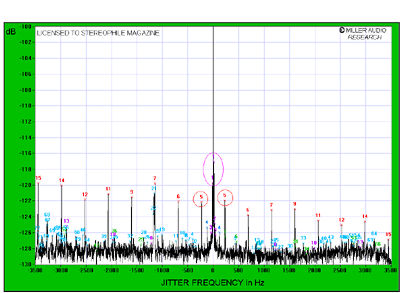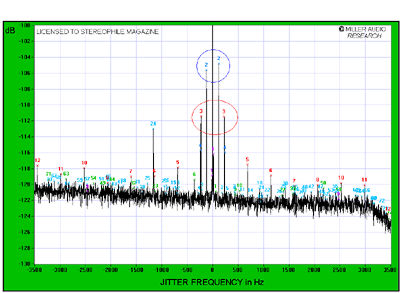Christer said:Let's say that zero feedback is when we have no feedback
loop spanning more than one amplifier stage.
I wouldn't say that. In the case of the Zen amp, we have a
feedback loop from Drain to Gate, which does not span more
than a single stage, yet it clearly is feedback.
If I put degeneration on the Source of the Zen Mosfet, I
would not call that feedback, but a resistor from Drain to
Gate, I call that a feedback loop - a connection from the input
to the output of a gain stage or series of gain stages.
😎
PMA said:And how about I/V converter and analog filter, regardless possible analog structure inside DAC? Do you think there are SE FET transistors there?
Actually, in the Ayre D-1x, there are complementary FET transistors, again with three between the DAC chip and the analog output. And using the Burr-Brown PCM1704 DAC chips with current output, there is no op-amp inside the DAC chip (unlike 99% of all DAC chips).
And how about I/V converter and analog filter, regardles possible analog structure inside DAC? Do you think there are SE FET transistors?
I/V converter is discrete and part of those 3 FETs, i don´t need much gain as i intend to drive 109dB/1W speakers. Internal structure of DAC is of course not SE FETS, but i wrote ">>between<< DAC and speaker" and i don´t consider it important digital logic transistors inside the DAC are CMOS pairs. The analog part of the DAC consists of trimmed thinfimresistors switched by transistors to the Iout. No opamp here.
Whats your problem with this ?
In exess I/V conversion with one FET would give all the voltage i need, only a source follower stage for current needed by speaker would be necessary. I also thought about making all the voltage needed with one tube stage (higher voltage), and one FET follower stage behind.
Nelsons posting above tells exactly what a layman like me does understand if you say feedback. Feed (sth.) Back. There must be some kind of pipe from the output to the mouth.
fdegrove said:Form a marketing POV, the way I perceive it, when the leaflet says no feedback used, they often refer to the fact that no GLOBAL FB loop is employed.
I would say that any loop feedback within an amplifier disqualifies
it as a "no feedback" amp. It can still be referred to as an
amplifier without global feedback, which means no connection
from the output to the input of the whole amp.
till said:Nelsons posting above tells exactly what a layman like me does understand if you say feedback. Feed (sth.) Back. There must be some kind of pipe from the output to the mouth.
Not necessarily the trivial explanation means the correct one.
Charles Hansen said:When it comes to complete amplifiers, we have such luminaries as Nelson Pass, John Curl, and Scott Wurcer (designer of the AD797, AD711/12, and many more) agreeing that referring to an amplifier circuit as "no feedback" or "zero feedback" is the correct terminology to use when only local degeneration is employed. And that's good enough for me.
Charles Hansen said:
You tell me.
About 400ps - that's fine. Isn't the noise floor a little bit higher?
Read Stereophile's full comments at:
http://www.stereophile.com/digitalsourcereviews/779/index5.html
You'll find Atkinson says "Note the higher-than-usual noise floor in this graph, which to some extent is due to the D-1x's lower-than-usual output level from its unbalanced output."
1) The D-1x was deliberately designed to have a lower than average output. This leads to a rise in the jitter floor measurement in this specific test due to the limitations of Stereophile's test setup, not the D-1x.
2) Atkinson used the unbalanced outputs. Again this was due to a limitation of his equipment, as it does not accept a balanced signal. Using the balanced outputs would result in improved measured results.
3) The same technology is used in our CD player which features a higher audio output level, resulting in improved results in this specific test. Please refer to the test of our CD player where Atkinson says, "The CX-7 did very well on this test, producing just 159 picoseconds of peak-peak jitter—among the lowest results I have measured."
http://www.stereophile.com/digitalsourcereviews/840/index4.html

http://www.stereophile.com/digitalsourcereviews/779/index5.html
You'll find Atkinson says "Note the higher-than-usual noise floor in this graph, which to some extent is due to the D-1x's lower-than-usual output level from its unbalanced output."
1) The D-1x was deliberately designed to have a lower than average output. This leads to a rise in the jitter floor measurement in this specific test due to the limitations of Stereophile's test setup, not the D-1x.
2) Atkinson used the unbalanced outputs. Again this was due to a limitation of his equipment, as it does not accept a balanced signal. Using the balanced outputs would result in improved measured results.
3) The same technology is used in our CD player which features a higher audio output level, resulting in improved results in this specific test. Please refer to the test of our CD player where Atkinson says, "The CX-7 did very well on this test, producing just 159 picoseconds of peak-peak jitter—among the lowest results I have measured."
http://www.stereophile.com/digitalsourcereviews/840/index4.html

PMA, whats your problem? In first line feedback is nothing but a word. A word usually means something, thats its meaning. This you call semantic. Feedback is a word made by two well known basic words glued together. We call these kind of words Kopulativum, i think in english it was copular. Feedback seems to be a Kopulativkomposita, what measn we can see its meaning by looking at the meaning of both basic words the copular was made of. What we get is something that is Feed (put into mouth or input end) back (coming from somewere more towads the output end. Of corse this needs some kind of connection between both points.
That you and some EEs call everything "feedback" what has an effect similar to this trivial to understand feedback is some different story. No normal (consumer, layman) person would call everything limiting or degenrating a signals input/output ratio "feedback". In this sense i would take it as one of all those crude technical terminology terms.
What you do at the moment is calles "Korinthenkacken" in my country, btw.
That you and some EEs call everything "feedback" what has an effect similar to this trivial to understand feedback is some different story. No normal (consumer, layman) person would call everything limiting or degenrating a signals input/output ratio "feedback". In this sense i would take it as one of all those crude technical terminology terms.
What you do at the moment is calles "Korinthenkacken" in my country, btw.
Hi,
Till,
No, you don't and no, it is not.
Splitting hairs, are we?
Jetzt bist du dran, Till....
Have fun,😉
Till,
We call these kind of words Kopulativum, i think in english it was copular.
No, you don't and no, it is not.
What you do at the moment is calles "Korinthenkacken" in my country, btw.
Splitting hairs, are we?
Jetzt bist du dran, Till....
Have fun,😉
"Compound words", much beloved in German. The ultimate German sentence contains one loooooong word, followed by the now-forgotten verb.
Hi,
"Beancounters" in U.S. English is slang for "accountants"
Actually that's a noun too....Schei**e.
Cheers,😉
Erbsenzählen...
"Beancounters" in U.S. English is slang for "accountants"
followed by the now-forgotten verb.
Actually that's a noun too....Schei**e.

Cheers,😉
SY said:"Compound words", much beloved in German. The ultimate German sentence contains one loooooong word, followed by the now-forgotten verb.
And especially amazing when directly translated into English ... 😉
Hi,
You don't want me to translate that one....
That's something you don't want to be fed back either. Yuk...
Cheers,😉
Ameisen*******en...
You don't want me to translate that one....

Schei**e.
That's something you don't want to be fed back either. Yuk...
Cheers,😉
- Status
- Not open for further replies.
- Home
- Amplifiers
- Solid State
- Charles Hansen come in please
